| On this page |
|
Houdini Engine for Unreal plug-in brings Houdini’s powerful and flexible procedural workflow into Unreal through Houdini Digital Assets (.hda). A Houdini artist can create a packaged digital assets with a network of nodes, inputs, and promoted paramteers. These can then be passed onto Unreal for an artist to make changes without using Houdini.
General information: ¶
Compatibility: ¶
Currently, the plugins has binaries for UE5.4 and UE5.3, and is linked with the latest production build of Houdini.
Source code for the plugin is available on the Git repository for UE5.4, 5.3.
Note
UE5 plugin versions use the same source files/branches, UE5.X sources are also intended for previous UE5 versions.
Support and reporting bugs: ¶
What are Houdini Digital Assets (HDAs) ¶
Houdini uses a node-based workflow and you build scenes using a network of nodes. These networks can be tools, assets, landscapes, geometry, curves, skeletal mesh, etc. From there, you can package these network of nodes into a Houdini Digital Asset known as an HDA.
See Introduction to digital assets for more information.
Plug-in session types ¶
This section briefly explains the differences between Session, Session Sync, and Node Sync and some common use cases for each.
Houdini Engine Session ¶
Houdini Engine Session allows you to import an HDA into Unreal and edit its inputs and parameters without Houdini. The packaged HDA could be a tool, procedural workflow, or assets using Houdini’s nodes and networks. The exposed inputs and parameter can then be further edited using Houdini asset details panel in Unreal. See Create a Session for more information.
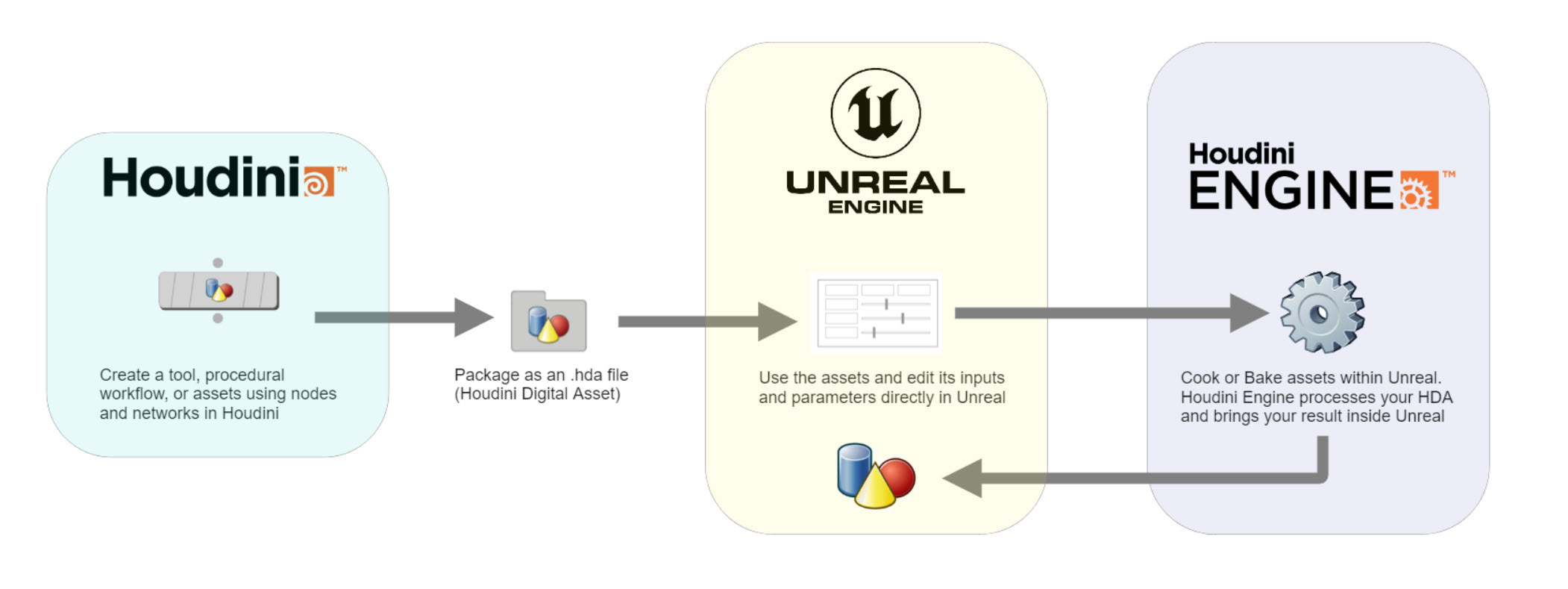
Houdini Engine Session use case ¶
Houdini Engine Session can be useful for Technical Artists with a team of artists who may not be familiar with Houdini. The Technical Artist can create a tool or procedural workflow with a set inputs and parameters that are exposed in the packaged HDA. These settings are then available to the artist in Unreal Engine through the Houdini Engine details panel.
See Using procedural modeling assets in Unreal for a workflow example.
Session Sync ¶
Session Sync supports all the features of Houdini Engine Session with a few additions. When you launch Session Sync, it opens a new Houdini that is synced between the Unreal and Houdini. You can sync changes in real-time to Houdini to allow for quick iteration and troubleshooting. See Using Session Sync for more information.
Some additional benefits include:
-
Houdini changes automatically update in Unreal
-
real-time feedback when building assets in Houdini
-
synchronize viewports in Unreal and Houdini
-
send HDA changes between Houdini and Unreal in real-time.
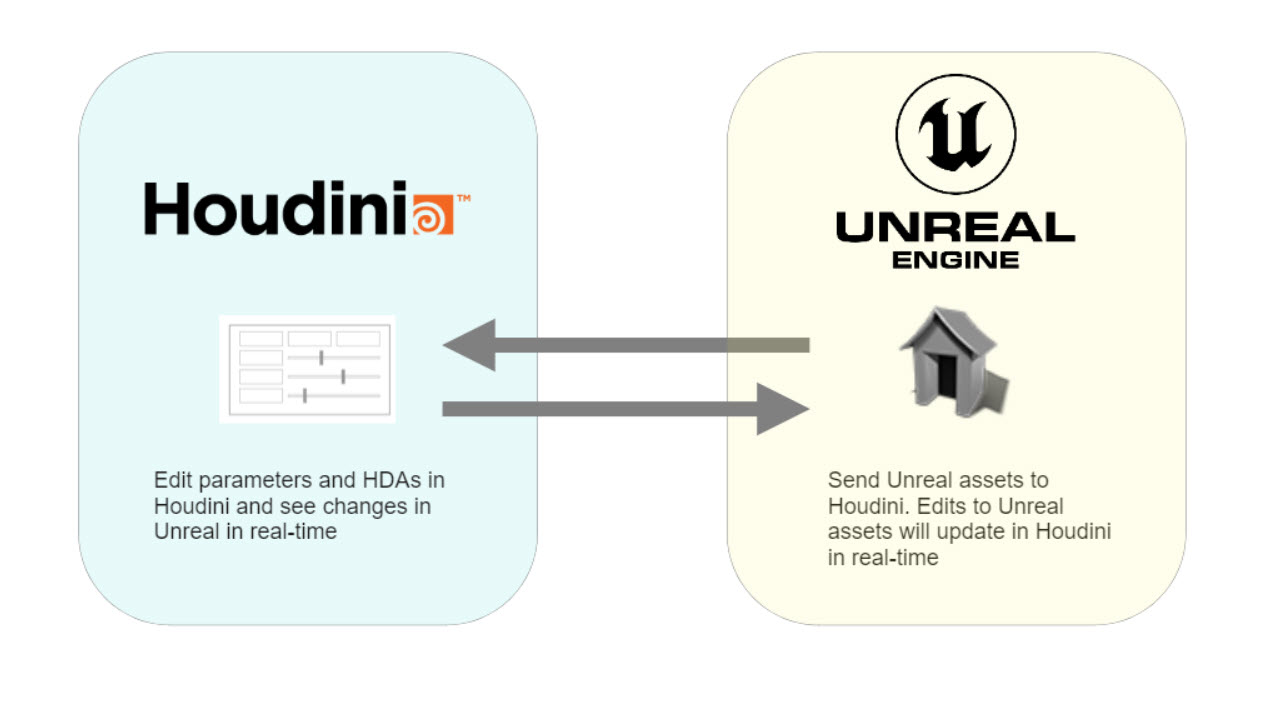
Session Sync use cases ¶
One Session Sync use case is to take parts of your level such as assets to create new content like geometry or simulation. An example is you kit bash a building in Unreal, you can then bring them into Houdini to build interiors, add building parts, re-UV it. From there, you can see the results in Unreal or export it in Houdini as a separate asset.
Another use case is to prototype tools with better context. You have an ivy tool and try to scatter it around your level in Unreal. The iterations to the tool would require constant back and forth to get the desired results. Instead, you can send the assets from Unreal into Houdini to iterate the tool while still retaining the context of the assets.
Node Sync ¶
Node Sync allows you transfer assets between Unreal and Houdini without a dedicated HDA. You can send any type of asset that’s supported by HDA inputs and fetch any asset types that can be outputted by the plugin. See Inputs and Outputs for more information on supported types.
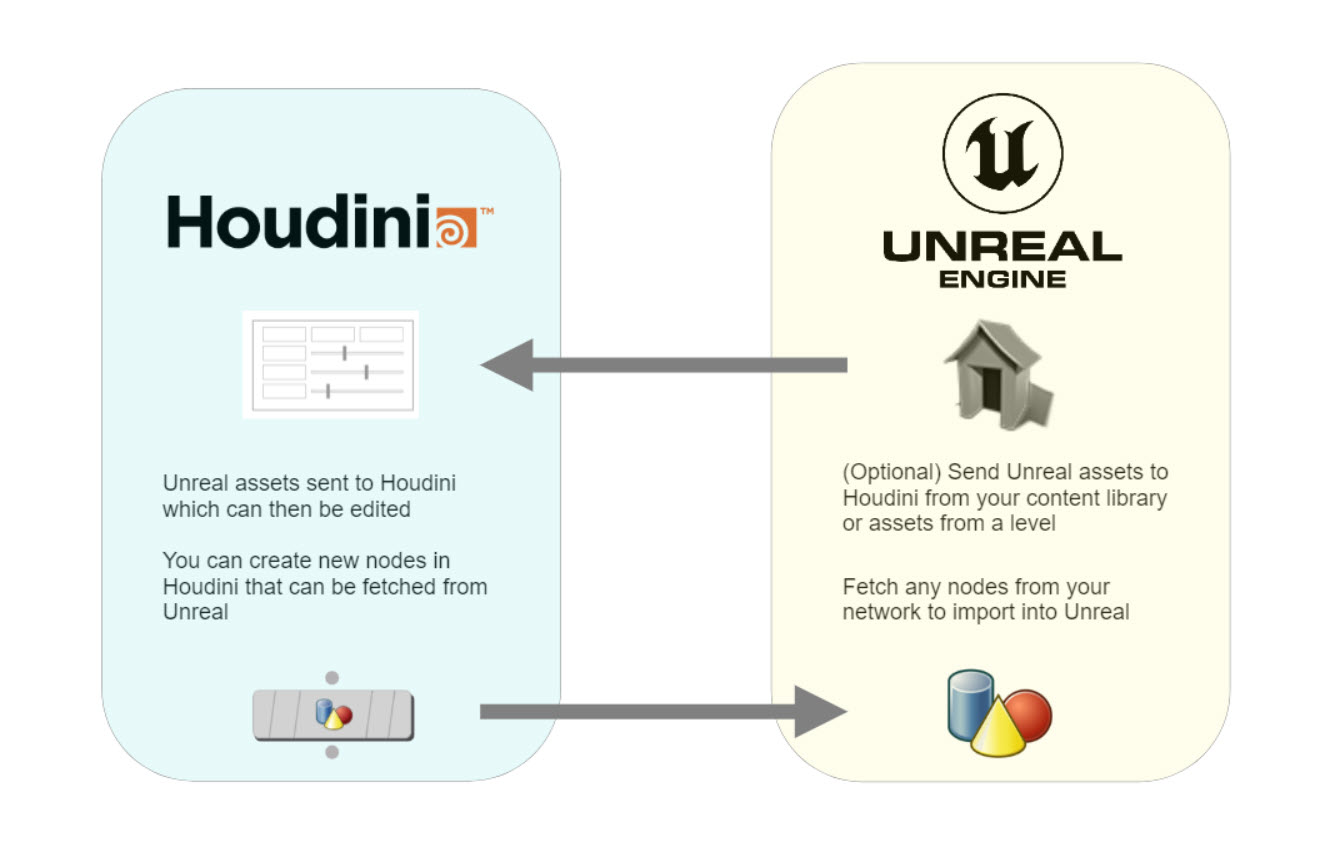
Node Sync use case ¶
One Node Sync use case is to test parts of your tool or node network that’s work in progress instead of packaging it as an HDA. An example is you have a building asset in Houdini, you can fetch the node in Unreal to check you it works with materials, curves, and the geometry are the right dimensions.
This also saves time for tools as they become larger and Node Sync doesn’t require you to constantly rebuild the HDA.
Houdini Niagara ¶
The Houdini-Niagara plugin allows you to exchange point cloud data between Houdini and Unreal’s Niagara system using the HoudiniNiagara Data Interface. You can export Houdini’s attribute data as HoudiniPointCache assets. These can then be imported into Unreal to use the Niagara systems and emitters to create complex effects and particle systems.
Houdini Live Link ¶
The Houdini KineFX Live Link plugin lets you control rigs in Unreal directly from KineFX in Houdini.
Inputs ¶
Input refers to sending data from Unreal to a Houdini Digital Asset (HDA). When you make changes to the input, it’s automatically pushed to the HDA and causes the output to be re-evaluated and recooked. See Inputs for more information.
Houdini Engine for Unreal supports the following input types:
The type of objects currently supported by the plugin’s inputs:
-
Static Mesh
-
Static Mesh Components
-
Instanced Static Mesh Component
-
Skeletal Mesh
-
Skeletal Mesh Components
-
BSP Brushes
-
Geometry Collection
-
Geometry Collection Component
-
Houdini Spline Components (Curve In)
-
Unreal Spline Components
-
Landscape
-
Landscape Splines
-
Spline Mesh Components
-
Foliage
-
Data Tables
-
Actors
-
Blueprints
-
Houdini Asset Actors
-
Level Instances
-
Packed Level Actors
-
Animations
Outputs ¶
Output refers to sending data from a Houdini Digital Asset (HDA) to Unreal. See Outputs for more information.
Houdini Engines for Unreal supports the following output types:
-
Static Meshes
-
Instancers and Foliage
-
Landscapes
-
Spline Component
-
Data Tables
-
Geometry Collection
-
Skeletal Mesh
-
Landscape Splines / Spline Meshes
-
Animaation Sequence
Parameters ¶
Parameters are the options in a node. These are important in HDAs to promote parameters and customize which parameters you want exposed for the end user. These parameters then appear as options in Unreal to modify.
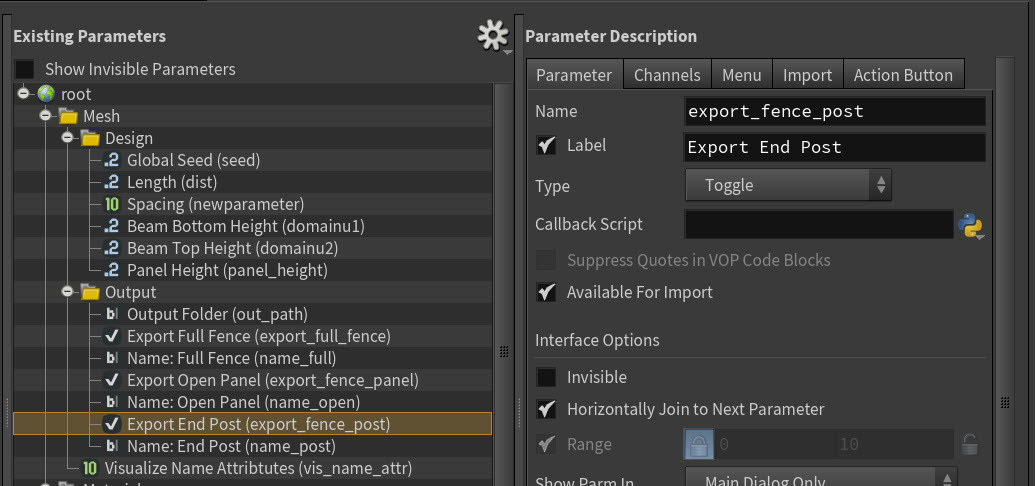
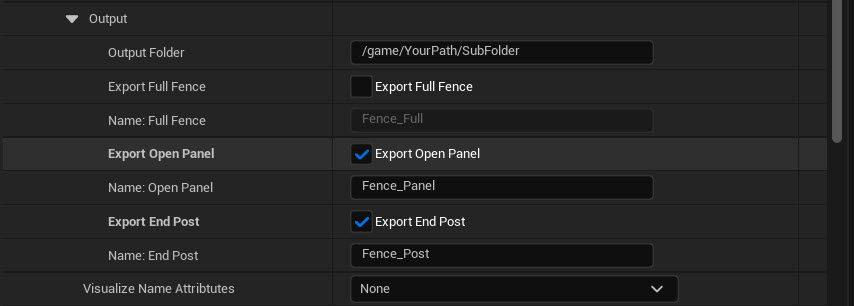
The following parameters are supported:
-
integers
-
floats
-
strings
-
buttons
-
colors
-
files
-
folders
-
labels
-
multiparams
-
ramps
-
separators
-
toggles
-
operator path
-
menus
-
button strips
Recook, rebuild, and bake assets ¶
When you import HDAs into Unreal, you can see these parameters in the Houdini Engine details panel. The parameters to rebuild, cook, or bake an asset controls the global behavior of your HDAs.
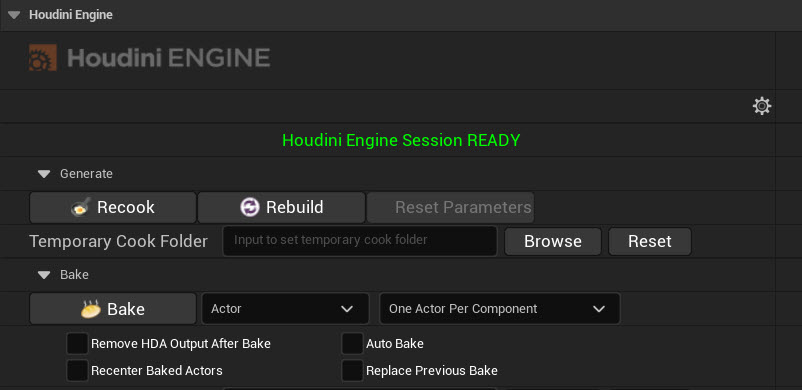
Recook assets ¶
When you recook an asset, the HDA processes and updates whether you made changes or not in the parameters. The term cooking is the same concept as in Houdini. The outputs of the HDA are recalculated when the cook is triggered. To see changes to your inputs and parameters within Unreal, you have to recook the asset.
Rebuild assets ¶
When you rebuild, the asset gets recooked and also reimports the HDA. This is useful when you have made changes in Houdini to your HDA and you want the new inputs or parameters to appear.
Bake assets ¶
When you bake an asset, this creates an Unreal asset or actor from your HDA. The original HDA remains unchanged but the new Unreal asset or actor is no longer connected to the HDA and all of its parameters.
This new Unreal asset or actor no longer requires the Houdini Engine for Unreal to function.